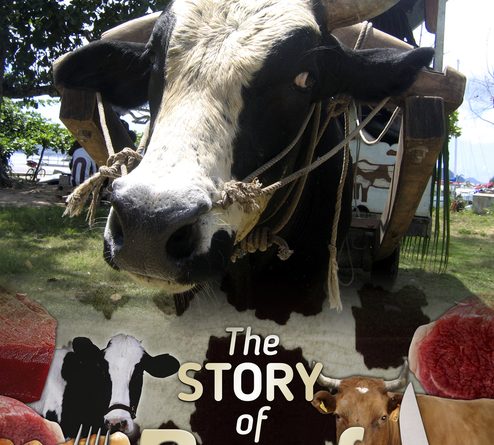
The Story of Beef
The tradition of eating beef has passed down generations to become an integral part for many of our regular diets. By providing precious protein, packed with fatty calories beef has come be regarded as an important ingredient for human survival.
Along with fellow presenters from around the world, this informative and entertaining episode joins Kate Comer on a voyage to discover the extraordinary journey behind the world’s favorite red meat.
Our programme begins at The South of England Society show which hosts and promotes farming, agriculture and the countryside. Here we meet Iain Nicol, CEO of the society who explains the importance of livestock at this spectacular event.
Whilst at the show, Kate meets Hannah Velton, historian and author of the book ‘Cow’ to discover more about the origins of beef consumption. Hannah draws on evidence of humans eating beef in prehistoric times as deciphered from early cave paintings’ depicting the hunt for aurochs, a primitive bovine. Similarly, in ancient India, the cow was once a source of meat rather than an object of worship and Holly Morris goes to New Delhi to learn more about the sacred cow.
The cow is, in fact, one of the most abundant and successful species on earth. At Bungehurst Farm in East Sussex, Kate learns about the biology of the modern day cow from Brenda Wear who manages the farms’ livestock.
To better understand the history of cattle breeding, which have been farmed in the UK for over 6000 years, we meet Mark Cleverdon, a commentator on Livestock at The South of England Agricultural Society. Mark tells Kate about the history of breeding the perfect cow and why long horn cows were bred to develop the more common short horn cow.
The United States is the top beef producing country supplying almost one-fifth of the world’s supply but in recent times, South America has become one of the world’s biggest beef exporters. Argentina is the major player having already farmed an estimated 52 million head of cattle in 2016.
Zay Harding heads to the plains of Patagonia to discover the life of the gauchos, the semi-nomadic horsemen and cowhands of the Argentinian grasslands. It was the Spanish who introduced the cow to the Americas but Hannah Velton explains its journey further north to the United States. Over in the heart of Oklahoma, Justin Shapiro discovers the legacy of the Wild West left behind by the American cattle cowboys.
Back in the UK, Andy Robertshaw, a military historian explains the importance of processed beef, known as corned beef, and the role it played in WW1 by preparing a typical meal for solders in the trenches. At Turner and George butchery in London, Jessica Wragg explains the difference between dry aging and wet aging.
At The Hereford, a restaurant in London, chef and co-founder Tom Pemberton explains to Kate why he believes eating offal is such a popular choice at his restaurant and prepares kidney, one of his signature dishes from the menu. To investigate if beef actually is good for our health, Phil Brooke from ‘Compassion in World Farming’ discusses the positive and negative aspects of eating meat. And Merriless Parker visits a small farm in Matsusaka, Japan to sample the most expensive beef money can buy.
The show concludes with Kate introducing us to beef delicacies from around the world: firstly in Texas, Zay Harding attempts to eat a 72-ounce steak, across the water in England, Rosie Lovell samples traditional English ‘roast beef’, in Philadelphia, Brianna Barnes samples their famous Philly Cheesesteak sandwich and in Malaysia, Merriless Parker is treated to a popular curry, spicy beef Rendang.
More information:
Study Guide: The Story of Beef
Credits
***
With thanks to:
***
Wikimedia
The South of England Agriculture Society
Bungehurst Farm East Sussex
Turner and George butchery
The Hereford Road Restaurant
Compassion in world farming
